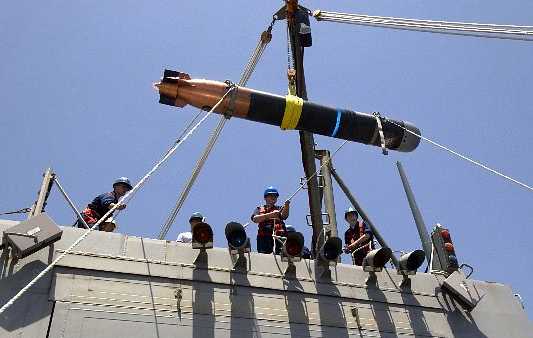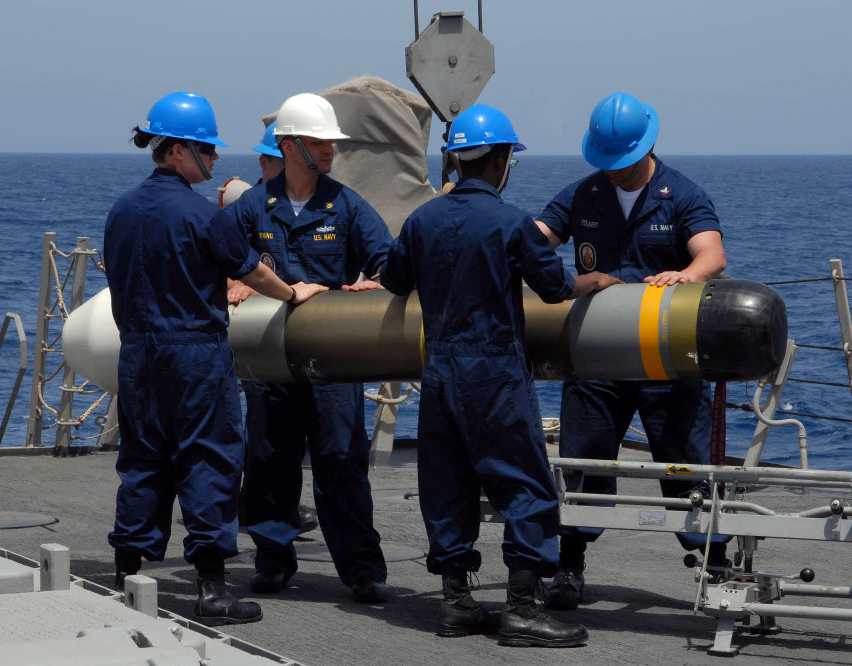The designations Mark 49, Mark 52 and Mark 53 were not assigned to programs.
| Ship Class Used On | Surface Ships |
|---|---|
| Date Of Design | 1942 |
| Date In Service | 1944 |
| Weight | 700 lbs. (318 kg) |
| Overall Length | 6 ft 11 in (2.108 m) |
| Explosive Charge | 107 lbs. (49 kg) HBX |
| Range / Speed | 9,600 yards (8,800 m) / 12 knots |
| Power | Electric-Battery |
| Guidance | Active acoustic |
A very small anti-submarine homing torpedo. Also known as the Mark 32 Mine. Intended to be dropped over the side by surface ships. Only ten Mod 1 torpedoes were completed by Leeds and Northrop before work was halted in 1945. An additional 320 Mod 2 torpedoes were manufactured by General Electric in the early 1950s. In service until 1955 when it was replaced by the Mark 43.
| Ship Class Used On | Submarines |
|---|---|
| Date Of Design | 1946 |
| Date In Service | 1949 |
| Weight | 1,770 lbs. (803 kg) |
| Overall Length | 13 ft 0 in (3.962 m) |
| Explosive Charge | 550 lbs. (249 kg) HBX |
| Range / Speed | 15,000 yards (13,710 m) / 27 knots |
| Power | Electric-Battery |
| Guidance | Passive acoustic |
A passive homer, originally called the Mark 33 mine. Intended for submarines and aircraft against surface ships or submarines. This was the first USN torpedo to have a cast aluminum alloy body. Thirty models produced and tested starting in 1943, but did not enter service. Some of its features were later used in the Mark 35.
| Ship Class Used On | Aircraft |
|---|---|
| Date Of Design | 1944 |
| Date In Service | 1948 |
| Weight | 1,150 lbs. (522 kg) |
| Overall Length | 10 ft 5 in (3.175 m) |
| Explosive Charge | Mod 0: 116 lbs. (53 kg) HBX Mod 1: 170 lbs. (77 kg) HBX |
| Range / Speed
(see text) |
3,600 yards (3,300 m) / 17 knots 12,000 yards (11,000 m) / 11 knots |
| Power | Electric-Battery |
| Guidance | Passive acoustic |
Initially known as the Mark 44 mine. An improved Mark 24 with magnetostrictive hydrophones. In service from 1948 to 1958 with approximately 4,050 produced. Had two batteries that were connected in parallel for searching at 11 knots and then connected in series for sprinting at 17 knots when attacking.
| Ship Class Used On | Submarines and Surface Ships |
|---|---|
| Date Of Design | 1946 |
| Date In Service | 1949 |
| Weight | 1,770 lbs. (803 kg) |
| Overall Length | 13 ft 5 in (4.089 m) |
| Explosive Charge | 270 lbs. (122.5 kg) HBX |
| Range / Speed | 15,000 yards (13,710 m) / 27 knots |
| Power | Electric-Battery, seawater |
| Guidance | Active and passive acoustic, spiral search |
A "Universal" torpedo derived from the Marks 24, 32 and 33 with about 400 being produced between 1949 and 1952. In service until 1960 when it was replaced by the Mark 37.
Final settings were provided from a fire control system to the weapon through a 1" (25 mm) diameter umbilical cable which was cut away during weapon expulsion from the tube. It was intended as an ASW weapon, with the secondary objective of anti-surface vessel attack.
Settings included a pre-enable run-out course and distance, search ceiling and floor, and right or left circling search pattern.
| Ship Class Used On | Submarine |
|---|---|
| Date Of Design | 1944 |
| Date In Service | 1948 |
| Weight | 4,000 lbs. (1,814 kg) |
| Overall Length | 20 ft 6 in (6.248 m) |
| Explosive Charge | 800 lbs. (53 kg) HBX-1 |
| Range / Speed | 7,000 yards (3,300 m) / 47 knots |
| Power | Electric-Battery, seawater |
| Guidance | Gyro, pattern running |
A pattern-running torpedo that did not enter service. Was intended to be superseded by the Mark 42.
| Ship Class Used On | ASW vessels |
|---|---|
| Date Of Design | about 1956 |
| Date In Service | Mod 0: 1957 Mod 1: 1960 Mod 2: 1967 Mod 3: 1967 |
| Weight | Mods 0 and 3: 1,430 lbs. (649 kg) Mods 1 and 2: 1,690 lbs. ( kg) |
| Overall Length | Mods 0 and 3: 11 ft 3 in (3.429 m) Mods 1 and 2: 13 ft 5 in (4.089 m) |
| Explosive Charge | All Mods: 330 lbs. (150 kg) HBX |
| Range / Speed | Mark 37: 10,000 yards (9,140 m) / 26 knots 23,500 yards (21,490 m) / 17 knots Mark NT37: 15,000 yards (16,400 m) / 36 knots |
| Power | Mark 37: Electric-Battery NT37: Otto fuel engine |
| Guidance | Mods 0 and 3: Active and passive acoustic Mods 1 and 2: Wire guided |
The Mark 37 was the standard US Submarine launched ASW torpedo of the 1960s and remained in service until the 1990s. It still survives in other nation's submarines as of 2004. An Argentine submarine launched one at a possible British submarine contact during the Falklands War.
Mod 0 was a free-running passive-active homing torpedo.
The success of the Mark 39 led to the development by Vitro Corporation and ORL of the Mark 37 Mod 1, a wire guided version of the Mark 37. This version began its long service with the fleet in 1960. The guidance system was generally similar to that of the Mark 39 with the incorporation of corrected intercept guidance (commands issued from the firing submarine to account for post-launch target maneuvers) in addition to the bearing rider mode. Command enabling and new search modes were also introduced with this mod. The Mark 37 Mod 1 was longer, slower and heavier than the Mod 0, but it offered greater target acquisition effectiveness and was more effective against agile submarines.
Mark 37 Mod 0 torpedoes were withdrawn from service and refurbished and reissued as Mod 3; Mod 1 torpedoes were similarly converted to Mod 2 with deliveries beginning in 1967. The refurbishing involved many changes, one of note being the switch from magnetostrictive to ceramic piezoelectric transducers. This change enhanced the acquisition range to about 1,000 yards (910 m) and avoided loss of sensitivity with depth.
The NT37 version replaced the battery with an Otto-fueled engine. This increased the speed by 40% and the range by 150%. This version with various mods remained in US Navy service until the early 1990s.
The Mark 37 was considered to be an excellent antisubmarine weapon until submarine speeds reached the 20+ knot range and diving depths began to exceed 1,000 feet (330 m). The probability of sinking or seriously damaging a submarine capable of over twenty knots with a twenty-four knot torpedo is quite low (unofficial figures give a 10% success rate for the Mark 37) and meeting such threats required new weapons. Significant upgrades of the Mark 37 were made during the 1980s and its progeny remain in service with many navies as the NT37C, D, E and F models. Compared to the Mark 37, all of these are much faster, operate deeper and boast modern solid state control systems. The US Navy, probably wisely, decided to develop new torpedoes to address the new threats rather than trying to enhance an elderly design.
When withdrawn from active service, many Mark 37 torpedoes were converted to Submarine Launched Mobile Mines (SLMM).
| Ship Class Used On | Submarine |
|---|---|
| Date Of Design | 1950s |
| Date In Service | Not in service |
| Weight | 3,008 lbs. (1,3,64 kg) |
| Overall Length | 20 ft 6 in (6.248 m) |
| Explosive Charge | 550 lbs. (249 kg) HBX |
| Range / Speed | 10,000 yards (9,140 m) / 35 knots |
| Power | Electric-Battery, seawater |
| Guidance | Active and passive acoustic |
Planned replacement for the Mark 28 but was cancelled in favor of the Mark 37.
| Ship Class Used On | Submarines |
|---|---|
| Date Of Design | 1955 |
| Date In Service | 1956 |
| Weight | 1,275 lbs. (578 kg) |
| Overall Length | 11 ft 1 in (3.378 m) |
| Explosive Charge | 130 lbs. (59 kg) HBX |
| Range / Speed | 13,000 yards (11,890 m) / 15.5 knots |
| Power | Electric-Battery |
| Guidance | Wire / passive acoustic |
A modification of the Mark 27 Mod 4, this was the first wire-guided torpedo to enter service in the USN. Modifications included the addition of a wire dispenser, appropriate controls and improved propulsion. The modifications were developed by ORL and Vitro Corporation. One hundred twenty torpedoes were converted by Philco and used, beginning around 1956, for fleet familiarization and evaluation, mainly in the seven SSK conversions of World War II fleet boats. In addition to the torpedo modifications, it was necessary to modify the fire control system to provide appropriate control signals and the torpedo tubes to accommodate the wire. About 3,000 were produced.
In operation the Mark 39 became a "bearing rider", that is, it was manually steered to keep it on the line of bearing from the launching submarine to the target. This form of guidance is not particularly efficient and it has other limitations among which are:
- Only one wire guided torpedo at a time can be launched and controlled
- During the run time of the torpedo, the maneuverability of the firing submarine is limited
- Torpedo noise masks the acoustic signature of the target
- The torpedo on the bearing line indicates the direction to the firing submarine
In spite of these limitations, the Mark 39 program clearly demonstrated the improved effectiveness of wire guidance against a maneuvering target.
| Ship Class Used On | Aircraft or Missile |
|---|---|
| Date Of Design | 1955 |
| Date In Service | Not in service |
| Weight | 1,250 lbs. (567 kg) |
| Overall Length | 8 ft 9 in (2.667 m) |
| Explosive Charge | 300 lbs. (136 kg) HBX |
| Range / Speed | 2,000 yards (1,830 m) / 80 knots |
| Power | Turbine, Lithium seawater |
| Guidance | Gyro |
High speed torpedo, aircraft or missile (ASROC) launched. There were two differing versions of this torpedo, neither of which entered service. The final version was to be turbine powered and pattern running. Meant to be the "ultimate non-homing torpedo." The Mark 40 propulsion system was interesting in that it used a multibase solid propellant to produce gas to drive a turbine, which, in turn, drove a pump-jet propulser. Pump-jets became an important propulsion system when submarines became much faster starting in the 1970s.
| Ship Class Used On | Aircraft |
|---|---|
| Date Of Design | 1948 |
| Date In Service | 1949 |
| Weight | 1,327 lbs. (602 kg) |
| Overall Length | 10 ft 0 in (3.048 m) |
| Explosive Charge | 150 lbs. (68 kg) HBX |
| Range / Speed | 8,000 yards (7,320 m) / 25 knots |
| Power | Electric-Battery, seawater |
| Guidance | Active and passive acoustic, spiral search |
Air launched version of the Mark 35. In service in 1949 but abandoned in favor of the Mark 43. About 200 produced.
| Ship Class Used On | Submarine |
|---|---|
| Date Of Design | 1950s |
| Date In Service | Not in service |
| Weight | 4,000 lbs. (1,814 kg) |
| Overall Length | 20 ft 6 in (6.248 m) |
| Explosive Charge | 800 lbs. (363 kg) HBX |
| Range / Speed | 20,000 yards (18,290 m) / 40 knots |
| Power | Navol |
| Guidance | Gyro, pattern running |
The Mark 42 was a post-war attempt to consolidate into one torpedo all that had been learned about torpedo sub-systems. The program seems to have toppled from its own weight, with five organizations having significant involvement in the program, and it was abandoned in favor of a pattern-running modification of the Mark 16. However, the Mark 42 was a significant milestone in that it was the last mark assigned to a US Navy non-homing torpedo.
| Ship Class Used On | Aircraft |
|---|---|
| Date Of Design | about 1948 |
| Date In Service | 1950 |
| Weight | 370 lbs. (168 kg) |
| Overall Length | 88.25 in (2.242 m) |
| Explosive Charge | 54 lbs. (24 kg) HBX |
| Range / Speed | 4,300 yards (3,930 m) / 20 knots |
| Power | Electric-Battery, seawater |
| Guidance | Active acoustic |
Electric air-launched ASW torpedo. Mod 0 was abandoned in favor of Mod 1 after 500 were built. A note on sources: "Ship Killers" says that the warhead for the Mod 0 was 370 lbs. (168 kg), an apparent misprint as this would be the same as the overall weight.
| Ship Class Used On | Surface and aircraft |
|---|---|
| Date Of Design | about 1951 |
| Date In Service | 1952 |
| Weight | Mod 1: 280 lbs. (127 kg) Mod 3: 265 lbs. (120 kg) |
| Overall Length | Mod 3: 91.5 in (2.324 m) |
| Explosive Charge | 54 lbs. (24.5 kg) HBX |
| Range / Speed | Mod 1: 4,500 yards (4,110 m) / 21 knots Mod 3: 4,500 yards (4,110 m) / 21 knots |
| Power | Electric-Battery, seawater |
| Guidance | Active acoustic |
Replaced by Mark 44 in 1957 after about 5,000 were produced. Fifty were sold to the British around 1955. A note on sources: "U.S. Naval Weapons" says that the diameter of these torpedoes was 10" (25.4 cm) but other sources say that they were the same 12.75" (32.4 cm) of other US ASW torpedoes.
| Ship Class Used On | ASROC and Ikara Launcher equipped ships |
|---|---|
| Date Of Design | about 1952 |
| Date In Service | 1960 |
| Weight | 425 lbs. (193 kg) |
| Overall Length | 100 in (2.540 m) |
| Explosive Charge | 75 lbs. (34 kg) HBX-3 |
| Range / Speed | 6,000 yards (5,490 m) / 30 knots |
| Power | Electric-Battery, seawater |
| Guidance | Helix search, active acoustic |
The Mark 44 was formerly the NATO standard light-weight homing torpedo. It was developed as the payload for the ASROC and Ikara anti-submarine missiles. Replaced by the Mark 46 in the USN, but still used in other navies as of 1995.
| Ship Class Used On | Submarines |
|---|---|
| Date Of Design | 1957 |
| Date In Service | 1963 |
| Weight | Mod 0: 2,330 lbs. (1,057 kg) Mod 1 and Mod 3: 2,213 lbs. (1,004 kg) |
| Overall Length | Mod 0: 225 in (5.715 m) Mod 1 and Mod 3: 227 in (5.766 m) |
| Explosive Charge | Mod 0: Mark 34 Nuclear warhead Mod 1 and Mod 3: Mark 102 Nuclear warhead |
| Range / Speed | 11,000 to 15,000 yards (10,000 to 13,650 m) / 40 knots |
| Power | Electric-Battery, seawater |
| Guidance | Gyro / wire |
Two solutions to the high speed, deep diving submarine problem were implemented. The first was the nuclear warhead incorporated in the Mark 45 (ASTOR). The torpedo itself was relatively conventional except for the use of a seawater activated battery to power a 160 hp electric motor. Guidance was by a gyro, depth gear and wire combination that used the attacking submarine's sonar to track the target. There was no homing capability. The warhead was detonated only by a signal sent along the wire; there was no contact or influence exploder in the torpedo. The wire guidance and command detonation were not only important in getting the torpedo to the target, they also satisfied the requirement for positive control of the nuclear warhead.
Development of the Mark 45 was completed in FY60, it was approved for service use in FY61 and production deliveries began in FY63. It was withdrawn from service in 1976 when the Mark 48 had demonstrated its capability and the advisability of using tactical nuclear weapons for ASW purposes became questionable. The basic Mark 45 torpedo was modified by Westinghouse to make a conventional torpedo for foreign military sales, the so-called Freedom torpedo. A few demonstration models were built but none were sold.
An Active or passive/active acoustic homing torpedo. Designed to attack high performance submarines, and is presently (2007) identified as the NATO standard. The Mark 46 Mod 5 torpedo is the backbone of the USN's lightweight ASW torpedo inventory and is expected to remain in service until the year 2015.
The Mark 46 torpedo is designed to be launched from surface combatant torpedo tubes, ASROC missiles and fixed and rotary wing aircraft. In 1989, a major upgrade program was begun to enhance the performance of the Mark 46 Mod 5 in shallow water. Weapons incorporating these improvements are identified as Mod 5A and Mod 5A(S).
- Mod 1
-
Computer logic added in 1970 to improve their performance against slow and/or periscope-depth targets.
- Mod 1 phase 2 (1971)
-
Improved shallow water capabilities and anti-countermeasures.
- Mod 2 (1971)
-
Additional computer logic improvements and a new autopilot.
- Mod 3
-
Cancelled.
- Mod 4
-
Payload for the CAPTOR (Mark 60) mine.
- Mod 5 (1984)
-
An almost completely new torpedo. Extensively modified by Honeywell, it also has the capability of attacking surface targets.
- Mod 6 (1989)
-
Slightly improved Mod 5 intended for the CAPTOR mine.
| Ship Class Used On | Aircraft and Surface Ships |
|---|---|
| Date Of Design | about 1964 |
| Date In Service | Mod 0: 1966 Mod 5: 1984 Mod 5A: 1989 Mod 5A(S): 1989 Mod 6: 1989 |
| Weight | Mod 0: 568 lbs. (258 kg) Mod 5: 518 lbs. (235 kg) |
| Overall Length | 102.36 in (2.600 m) |
| Explosive Charge | Mod 0: N/A Mod 5: 98 lbs. (44.5 kg) PBXN-103 |
| Range / Speed | Mod 0: N/A Mod 5: 8,000 yards (7,300 m) / 45 knots |
| Power | Two-speed, reciprocating external combustion; Mono-propellant (Otto fuel II) fueled |
| Guidance | Active or passive/active acoustic |
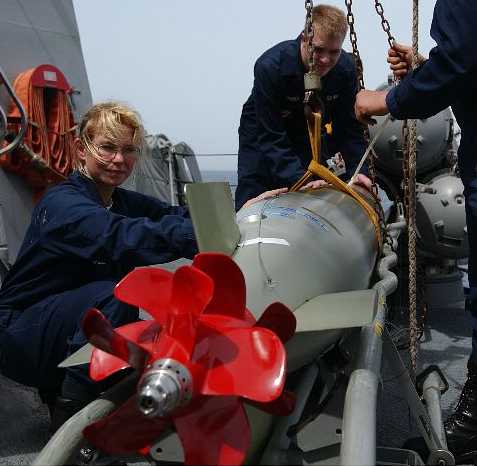
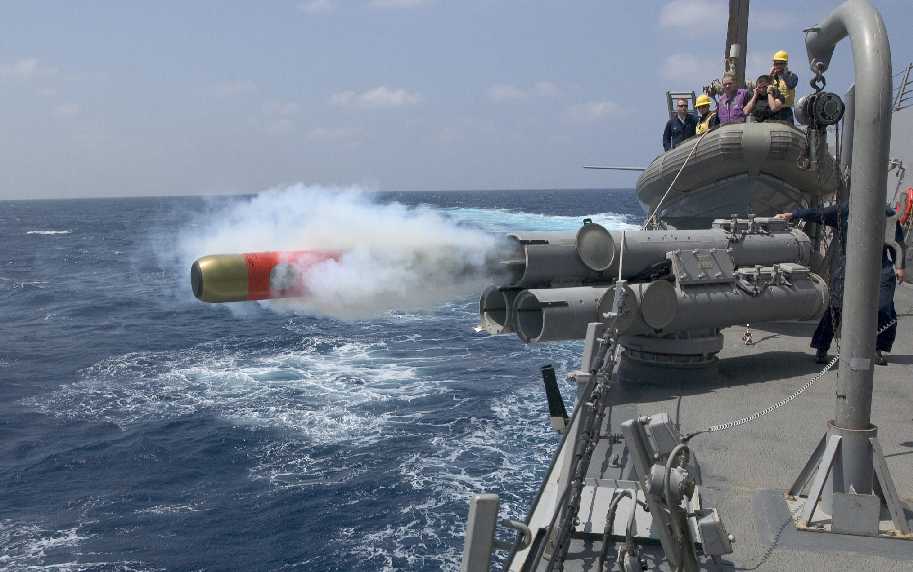
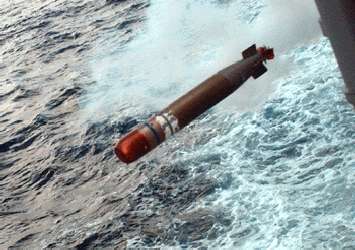
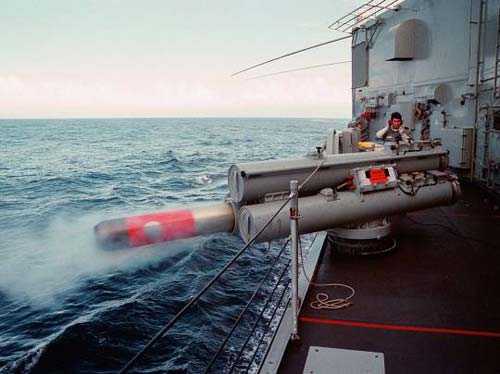

Proposed submarine anti-ship torpedo. The development program was terminated in favor of the Mark 48.
| Ship Class Used On | Submarines |
|---|---|
| Date Of Design | about 1970 |
| Date In Service | Mark 48: 1972 Mark 48 ADCAP: 1988 |
| Weight | Mark 48: 3,434 lbs. (1545.3 kg) Mark 48 ADCAP: 3,695 lbs. (1662.75 kg) Mark 48 Mod 6: 3,520 lbs. (1,597 kg) |
| Overall Length | 19 ft 0 in (5.790 m) |
| Explosive Charge | 650 lbs. (292.5 kg) PBXN-103 This is equivalent to about 1,200 lbs. (544 kg) of TNT |
| Range / Speed | 10,000+ yards (9,000+ m) / 28+ knots (official figures; see text) |
| Power | Axial flow pump jet propulser with twin contra-rotating propellers driven by an external swashplate combustion gas piston engine |
| Guidance | Wire guided, active and passive acoustic |
The Mark 48 is designed to combat fast, deep-diving nuclear submarines and high performance surface ships. It is carried by all Navy submarines. The improved version, Mark-48 ADCAP (for ADvanced CAPabilities), is carried by attack submarines and Ohio class (SSBN-726) ballistic missile submarines. The Mark 48 replaced both the Mark 37 and Mark 14 torpedoes. Mark 48 and Mark 48 ADCAP torpedoes can operate with or without wire guidance and can use active and/or passive homing. When launched they execute programmed target search, acquisition and attack procedures. Both can conduct multiple reattacks if they miss the target.
The non-nuclear approach to the high speed, deep diving submarine was a very fast, deep-diving torpedo with a high performance guidance system, that is, a much improved Mark 37 that would take full advantage of post-World War II technology. Consideration of such weapons, both submarine launched and air launched, began in November 1956 as part of the RETORC (Research Torpedo Re-Configuration) program. By 1960 a specific heavy weight torpedo project had emerged and designated first as EX 10 and later as Mark 48. After a bidder qualification exercise and competition between the qualified bidders, a project definition contract was awarded to Westinghouse. A parallel contract was awarded to Clevite for the development of an alternative acoustic system. The Westinghouse contract was subsequently extended to include the development of the turbine powered Mark 48 Mod 0 which had only an ASW capability. Some Mod 0's were produced for evaluation, but by 1967 it had been decided that an anti-surface vessel capability was also needed. Some feeling persists that this was more of a ploy to keep Clevite in the running than a significant operational requirement.
A competition between the Mark 48 Mod 1, which had emerged in rudimentary form from the Clevite contract, and Mark 48 Mod 2, a redesign of the Westinghouse Mod 0 followed. The Westinghouse torpedo used a Sunstrand turbine, as used in the Mod 0, for propulsion, while Clevite used Otto fuel in an external combustion, axial piston engine. One of several selection factors was apparently the better efficiency of the piston engine, especially when running deep, as opposed to the quieter, but less efficient turbine. The acoustic systems were also somewhat different. In 1971, after competitive evaluation, a full scale production contract was awarded to Gould15 (formerly Clevite). The first Mark 48 Mod 1 torpedoes were delivered to the fleet in 1972, twelve years after the development characteristics had been approved.
Frequently published, but unofficial, data indicate that the Mod 0 was capable of 55 knots for 35,000 yards (32,000 m) and could operate as deep as 2,500 feet (760 m), but not at maximum speed. Its acoustic homing system is reported to have an acquisition range of 4,000 yards (3,640 m), about four times that of the Mark 37. This performance is impressive and generally adequate for dealing with 30+ knot, deep-diving targets.
The combination of substantial on-board capability (HCL) to control search, homing and re-attack maneuvers and wire guidance provides a formidable weapon. The addition of two way communication (TELCOM) in the Mod 3 provided data from the torpedo sonar and actual torpedo operating data (course, speed, depth etc.) to the submarine fire control system, thus substantially enhancing performance. Mod 4 added envelope expansion features, including increased speed and deeper diving, and a fire and forget capability. Existing torpedoes were upgraded by kits and Mod 4s were production torpedoes from 1980 on. Mod 5 was an interim upgrade of existing torpedoes pending the availability of ADCAP. The Mark 48 torpedo had teething problems, but it is a very sophisticated, high performance weapon. Published photographs of the destruction of targets attest to its effectiveness. The main technical criticism of the Mark 48 seems to be that it is very noisy.
Prior to the mid-1960s, Soviet submarines had diving depths of 650 to 1000 feet (200 to 330 m) and submerged speeds under 30 knots. Early Mark 48 capabilities were clearly capable of attacking such targets. The advent of the Soviet ALPHA submarine with its non-magnetic titanium hull, 2,500 foot (760 m) diving depth and submerged speed in excess of 40 knots apparently produced a validated threat against which the Chief of Naval Operations issued a new operational requirement in 1975. Two approaches to satisfying this requirement were initiated. The first was the Mark 48 "envelope expansion program" which exploited the capabilities of the existing torpedo. The second was essentially a new torpedo, ADCAP. The major changes in ADCAP involved entirely new digital electronics, inertial guidance (replacing the gyro system), a major reduction in volume devoted to electronics, with a corresponding major increase in fuel capacity, a strengthened shell and inclusion of the Mark 48 envelope expansion features. The Mark 48 piston engine was retained, but given a greater fuel flow rate which yielded an estimated 63 knot speed. Much of this change was made possible by the introduction of integrated circuits, including microprocessors, whose small size made it possible to move many of the functions of the control group into the nose. The guidance wire spool was moved to a position aft of the enlarged fuel tank and other layout changes were made. Authorized for full production in 1990 as the Mod 5, the last new ADCAP torpedo was delivered in 1996.
The Mark 48 Mod 6 torpedo had two significant enhancements: Guidance and control (G&C Mod) and in the torpedo propulsion unit (TPU Mod). The G&C Mod improved the acoustic receiver, replaced the guidance-and-control set with updated technology, increased memory, and improved processor throughput. The TPU Mod provided a tactically significant reduction in torpedo radiated-noise signatures, thus addressing one of the largest complaints about earlier versions. The Mod 6 reached Initial Operational Capability (IOC) in 1997. The Mod 6 was also the first torpedo that could utilize the Torpedo Downloader System (TDS). The TDS can provide rapid software updates to embarked weapons, allowing submarines to deploy with the most up-to-date software variant.
The Mark 48 ADCAP underwent a Block IV upgrade which commenced in 1999. The Navy acquired about 1,046 MODs ADCAPS (Mod 6) which replaced an equivalent number of Mod 5 ADCAPS, maintaining the total inventory of ADCAP torpedoes at 1,046.
The Mark 48 Mod 7 Common Broadband Advanced Sonar System (CBASS) torpedo is optimized for both the deep and littoral waters and has advanced counter-countermeasure capabilities. The Mark 48 ADCAP Mod 7 (CBASS) torpedo is the result of a Joint Development Program with the Royal Australian Navy and reached Initial Operational Capability in 2006.
The following description is adapted from "Jane's Background Information: Mk 48 ADCAP" (see link below):
The Mark 48 ADCAP Mod 6 (MODS) features two hardware upgrades: One for guidance and control and the other a propulsion upgrade. The guidance and control upgrade replaced the previous guidance and control unit with more modern technology, improved the acoustic receiver, added additional memory and improved processor throughput to handle the expanded software demands anticipated for near term upgrades. The torpedo propulsion upgrade improved the propulsion unit, details of which are classified.
Included in the upgrade is a Common Broadband Advanced Sonar System (CBASS) program, which will develop a fully digital wideband sonar capability to enable the torpedo to operate effectively both in shallow water (<180 m) to counter diesel electric submarines operating in the littoral and deep water environments. For this the torpedo will also feature frequency agility and optimal frequency selection. This capability will allow the Mark 48 ADCAP to identify torpedo countermeasures and discriminate them from the target. Full rate production of this upgrade is scheduled to begin in FY04.
The Stealth Torpedo Enhancement Program (STEP) will be introduced in two phases. Phase 1 will build on the CBASS capability providing guidance upgrades and eliminate sonar footprints, while Phase 2 will see stealthy and higher power density propulsion improvements and an upgraded warhead.
The Mark 48 has been exported to Australia, Canada, Israel, Netherlands and Turkey (in ex-US Navy submarines).
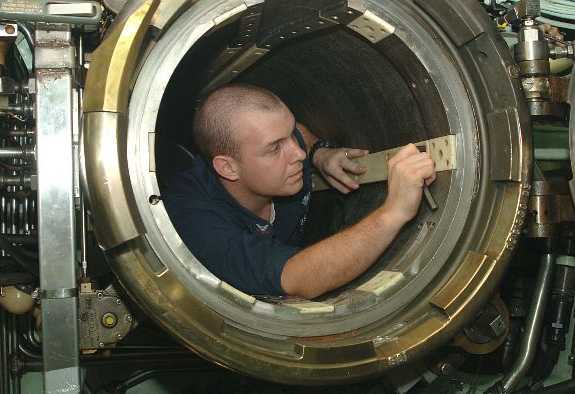
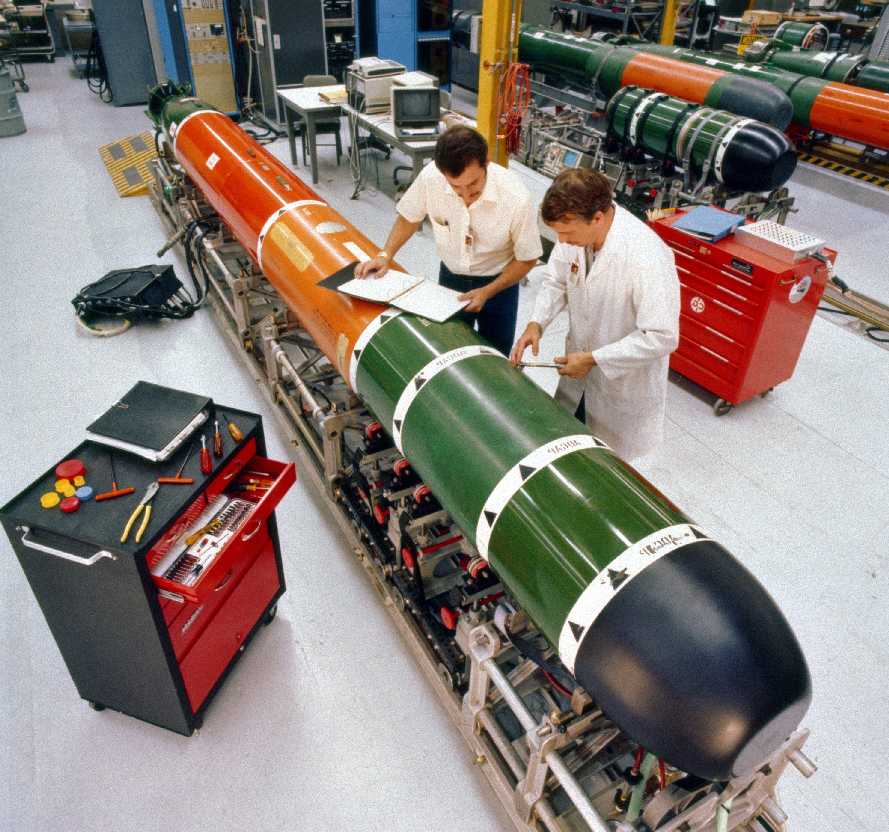
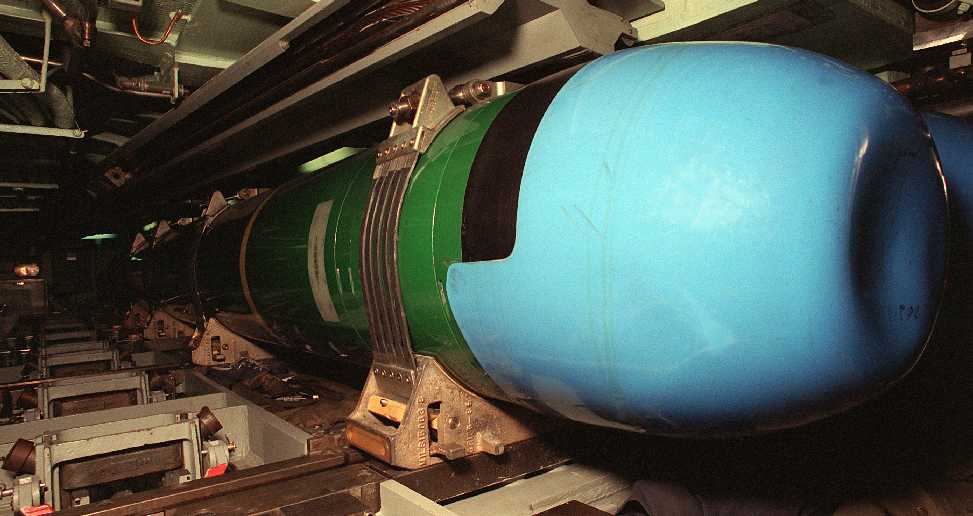
| Ship Class Used On | Aircraft and Surface Ships |
|---|---|
| Date Of Design | 1972-78 |
| Date In Service | 1981 |
| Weight | 750 lbs. (340 kg) |
| Overall Length | 112 in (2.845 m) |
| Explosive Charge | 100 lbs. (45 kg) HE Shaped-Charge |
| Range / Speed | Classified / 40+ knots |
| Power | Piston / Stored Chemical Energy Propulsion System |
| Guidance | Spiral pattern search, active and passive acoustic |
Honeywell's Advanced Light Weight Torpedo (ALWT). A very small anti-submarine homing torpedo. The Mark 50 is an advanced lightweight torpedo for use against the faster, deeper-diving and more sophisticated submarines such as the Soviet Alpha class. The Mark 50 can be launched from all ASW aircraft and from torpedo tubes aboard surface combatant ships.
The McDonnell Douglas design for the lightweight ASW torpedo program. Lost in competition to the Honeywell/Garret Mark 50 design.
| Ship Class Used On | Aircraft and Surface Ships |
|---|---|
| Date Of Design | 2000 |
| Date In Service | 2004 |
| Weight | 608 lbs. (276 kg) |
| Overall Length | 106.9 in (2.715 m) |
| Explosive Charge | 96.8 lbs. (44 kg) HE Shaped-Charge |
| Range / Speed | Classified / 40+ knots |
| Power | Two-speed, reciprocating external combustion; Mono-propellant (Otto fuel II) fueled |
| Guidance | active and passive acoustic |
The Mark 54 "MAKO" Lightweight Torpedo was previously known as the Lightweight Hybrid Torpedo (LHT).
Raytheon's Naval & Maritime Integrated Systems (N&MIS) in partnership with the Navy's Undersea Weapons program office and the Naval Undersea Warfare Center (NUWC) developed a hybrid torpedo that combined the Mark 50 search and homing systems with a Mark 46 propulsion system. The Mark 54 torpedo is intended to improve the shallow water capability of air-launched torpedoes and to be effective against quiet diesel-electric submarines operating in the shallow-water littoral environment. In addition to the other off-the-shelf items, this torpedo will also make extensive use of COTS electronic components. The Mark 54 entered full service production in 2004 with a first order of 24 torpedoes at a cost of about $1,000,000 US (one million) each.
The MAKO, with better sonar and processing capability than the Mark 46, will still be handicapped by shortfalls in some characteristics. For this reason, the Navy's current plan to develop the LHT as a relatively cheap substitute for the Mark 50 may not yield an operationally effective weapon in a war-fighting scenario without significant improvements in target locating ability and weapons placement accuracy.
Lockheed Martin has recently won a contract to adapt their LongShot® Wing Adapter Kit to the Mark 54. This is a discardable wing assembly that allows the launch of various munitions including mines and torpedoes from high altitudes and at long standoff ranges. Currently, ASW aircraft such as the P-3 have to make a time-consuming descent from their surveillance altitudes of 30,000 feet (9,100 m) to a release altitude of 300 - 1,000 feet (90 - 300 m) in order to launch a torpedo. Quoting from a 13 June 2006 Lockheed Martin Press Release:
"The LongShot is a low-cost, self-contained wing adaptor kit that provides range extension and autonomous guidance to a family of existing air-to-surface munitions, including sea mines, gravity bombs, laser-guided bombs and tactical munitions dispensers. No aircraft modification is required to deploy a LongShot equipped munition. The system is completely self-contained, including a flight control computer, a GPS-based navigation system and power sources and does not require an electrical interface with the aircraft."
The Navy is also working on a VL-ASROC variant designated as RUM-139C. This is to be fired from the standard Mark 41 Vertical Lanuch System carried aboard many US warships.
This torpedo program suffered from cost overuns and high production costs, limiting the numbers that can be purchased.
"Naval Weapons of World War Two" by John Campbell
"US Naval Weapons" and "The Naval Institute Guide to World Naval Weapons 1991/92" and "1994 Update" all by Norman Friedman
"US Navy Torpedoes" articles by Frederick J. Milford in "Submarine Review" starting in April 1996
"From Fancy to Stingray: British Torpedoes since 1945" article by Antony Preston in "Warships Volume V"
"Ship Killers: A History of the American Torpedo" by Thomas Wildenberg and Norman Polmar
---
US Navy Fact File
Royal Australian Navy
"Jane's Background Information: Mk 48 ADCAP" article of 02 February 2001
Lockheed Martin Press Releases
Raytheon Press Releases
---
Special help from James V. Shannon
31 October 2008 - Benchmark
20 December 2010 - Updated data tables to include guidance systems and other information
28 December 2013 - Added photograph of Ikara ASW rocket
04 February 2017 - Converted to HTML 5 format and added details on Mark 43 Mods 0, 1 and 3
05 October 2019 - Added links to other USA Torpedo datapages
08 September 2021 - Added information to Mark 37


